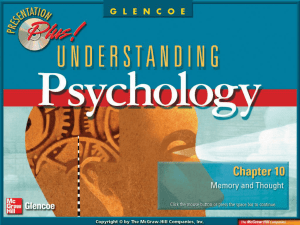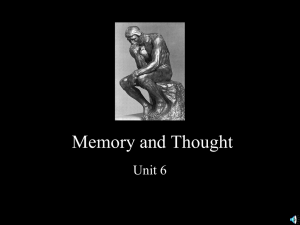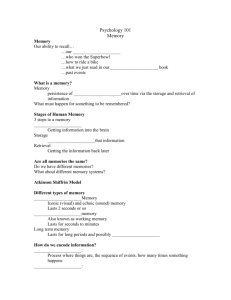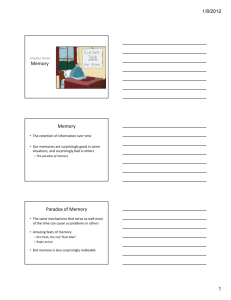Introduction to Psychology (Frank Winstan)
advertisement
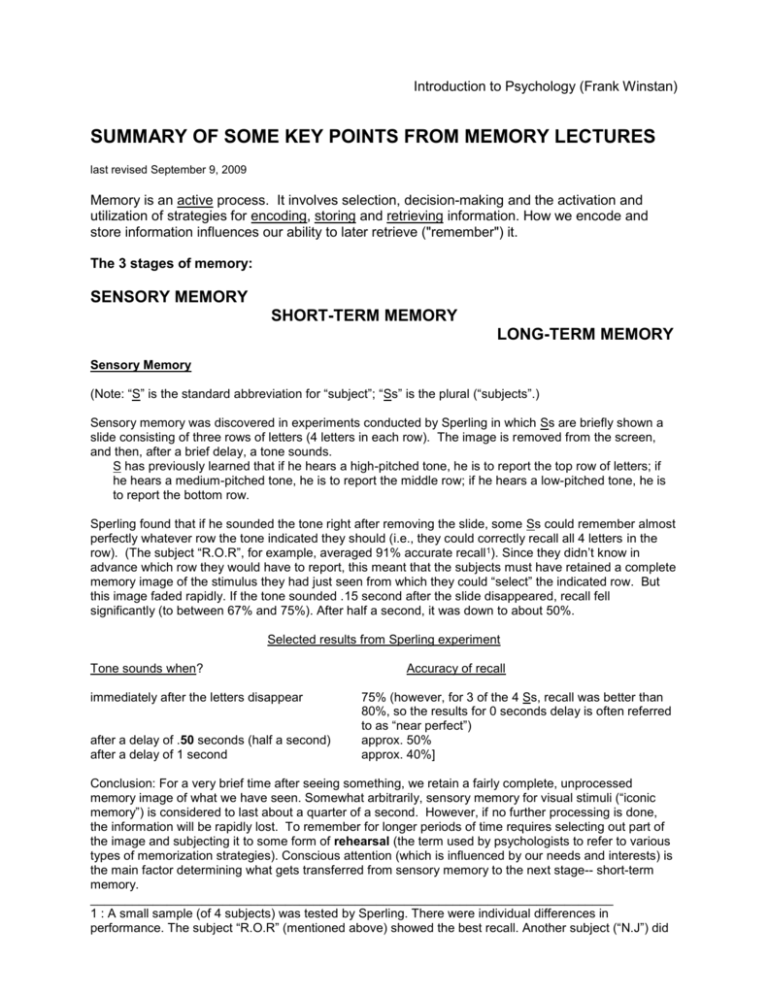
Introduction to Psychology (Frank Winstan)
SUMMARY OF SOME KEY POINTS FROM MEMORY LECTURES
last revised September 9, 2009
Memory is an active process. It involves selection, decision-making and the activation and
utilization of strategies for encoding, storing and retrieving information. How we encode and
store information influences our ability to later retrieve ("remember") it.
The 3 stages of memory:
SENSORY MEMORY
SHORT-TERM MEMORY
LONG-TERM MEMORY
Sensory Memory
(Note: “S” is the standard abbreviation for “subject”; “Ss” is the plural (“subjects”.)
Sensory memory was discovered in experiments conducted by Sperling in which Ss are briefly shown a
slide consisting of three rows of letters (4 letters in each row). The image is removed from the screen,
and then, after a brief delay, a tone sounds.
S has previously learned that if he hears a high-pitched tone, he is to report the top row of letters; if
he hears a medium-pitched tone, he is to report the middle row; if he hears a low-pitched tone, he is
to report the bottom row.
Sperling found that if he sounded the tone right after removing the slide, some Ss could remember almost
perfectly whatever row the tone indicated they should (i.e., they could correctly recall all 4 letters in the
row). (The subject “R.O.R”, for example, averaged 91% accurate recall1). Since they didn’t know in
advance which row they would have to report, this meant that the subjects must have retained a complete
memory image of the stimulus they had just seen from which they could “select” the indicated row. But
this image faded rapidly. If the tone sounded .15 second after the slide disappeared, recall fell
significantly (to between 67% and 75%). After half a second, it was down to about 50%.
Selected results from Sperling experiment
Tone sounds when?
immediately after the letters disappear
after a delay of .50 seconds (half a second)
after a delay of 1 second
Accuracy of recall
75% (however, for 3 of the 4 Ss, recall was better than
80%, so the results for 0 seconds delay is often referred
to as “near perfect”)
approx. 50%
approx. 40%]
Conclusion: For a very brief time after seeing something, we retain a fairly complete, unprocessed
memory image of what we have seen. Somewhat arbitrarily, sensory memory for visual stimuli (“iconic
memory”) is considered to last about a quarter of a second. However, if no further processing is done,
the information will be rapidly lost. To remember for longer periods of time requires selecting out part of
the image and subjecting it to some form of rehearsal (the term used by psychologists to refer to various
types of memorization strategies). Conscious attention (which is influenced by our needs and interests) is
the main factor determining what gets transferred from sensory memory to the next stage-- short-term
memory.
___________________________________________________________________________
1 : A small sample (of 4 subjects) was tested by Sperling. There were individual differences in
performance. The subject “R.O.R” (mentioned above) showed the best recall. Another subject (“N.J”) did
much more poorly and brought the group average down. The chart on page 241 of the Textbook shows
the average results for the 4 subjects for some of the delay intervals tested.
Short-term Memory (STM)
The next stage of the memory process is called short-term memory (STM). Information in STM will
remembered for longer than when it is in sensory memory, but it is still "fragile", lasting less than 30
seconds unless one engages in some form of maintenance rehearsal. Many people use repetition-- the
most common maintenance rehearsal strategy- to keep newly-acquired information "alive" in short-term
memory. Experiments designed to prevent rehearsal reveal the limited duration of short-term memory.
In one experiment (Peterson & Peterson, 1959), rehearsal was prevented by tying up Ss' attention
(e.g., by having them count backwards, by 3s from 3,457!) right after they had seen the "trigram" they
were supposed to remember. (A trigram is a sequence of 3 letters which do not form a meaningful
word; e.g., V Q F )
After 12 seconds, most subjects had forgotten the trigram that they had seen (accurate recall
occurred on about 20% of the trials).
After 15 seconds, accurate recall occurred just slightly more than 10% of the time.
The "capacity" of STM is also limited: The number of individual items (bits) of information that can be held
in STM is approximately 7 (plus or minus two- i.e., the range for the population is between 5 and 9 bits of
information).
[Note 2: The term "interference" is (unfortunately) used in two ways by psychologists to refer to different
memory-related phenomena. You will first encounter the term on p. 242 of the Textbook as part of the
discussion of the limited capacity of short-term memory. Given that short-term memory has a finite, limited
capacity, new information tends to “push out” or overwrite or displace information that may be in shortterm memory at a given moment in time. Interference also refers to processes which block or inhibit our
ability to retrieve information from or store new information in long-term memory (see discussion on pp.
265-266 of the Textbook)]
To overcome the limitation on the number of items of information that one can hold in STM, most people
try to group individual items into larger units. Psychologists refer to this process as chunking. For
example, the numbers 6 8 1 1 7 5 0 1 9 9 could be grouped as 681 1750 199, and readily remembered
as such. [If the chunks are meaningful (e.g., 681 is identified as a common phone exchange in Laval), the
information may be transferred at once to long-term memory- see below.]
Chunking is one of the reasons that chess masters can remember so much after just a glance at a chessboard.
If the pieces on the board are arranged as they might be in a real game, the chess master can usually pick out
familiar patterns (incorporating several pieces) and can then store these larger "chunks" of information in
memory. A non-player would generally have to store the information in a far less efficient manner; e.g., “there's a
black piece that looks like a horse on the second row from the bottom, three squares from the left side of the
board. Two squares to the right is a .......piece that looks like part of an old castle”; etc. Interestingly, when chess
pieces are arranged randomly on the board, a chess master's ability to remember board patterns is generally no
better than that of a non-player (who has been taught the names of the various pieces-rook, pawn, queen, etc.).
[Note 3: The memory “expert” Rajan (discussed by Plotnik on p. 243) is using chunking as a memoryenhancing strategy, but he’s doing other things as well. Chunking refers simply to grouping bits of
information into larger units. Rajan’s naming of and his attempts to associate his “chunks” with meaningful
people, dates etc. are examples of elaborative rehearsal (see p. 249). Do not confuse this with chunking.]
Psychologists have noted several important differences between STM and LTM (long-term memory):
* As noted, STM has a limited capacity; the capacity of LTM has no known limits.
2
* The type of errors that people make when recalling information from short-term as opposed to long-term
memory are different, and they suggest differences in the way that information is processed for short-term
as opposed to long-term storage. If a subject is asked to recall the words from a list she has just seen,
she might remember "feet" instead of "heat". This suggests that the information she acquired (and held in
short-term memory) has been processed acoustically (in terms of sound patterns). Errors made when
recalling info from LTM tend to be semantic in nature (related to meaning)-e.g., "house" might be recalled
instead of "cabin". This suggests that in processing verbal information for long-term storage, we deal with
it at a "deeper" level-we focus on its meaning.
* The most fundamental difference between STM and LTM is the length of time that information can be
held in each. The most dramatic evidence for this difference comes from studies of people with damage
to a part of the brain called the hippocampus The first and most famous case of this nature was reported
by researchers at the Massachusetts Institute of Technology who studied a patient whom they referred to
in their reports as "H.M.". Surgery to relieve epilepsy had destroyed most of H.M.'s hippocampus, and it
soon became apparent that this brain injury had profoundly altered H.M.'s memory system:
* He could still remember what he had known prior to the surgery;
* but he could no longer retain newly-acquired information for more than half-a-minute or so unless
he kept repeating it over and over (out loud, or in his mind). He appeared to have lost the ability to
"transfer" this information to long-term storage. Most things that he heard or saw were apparently
forgotten within seconds. H.M. was deeply shocked and stricken with grief when he was told that his
favourite uncle had died. But moments after hearing the news, he appeared to have forgotten it. A
couple of days later, a friend who had come to visit offered his condolences to H.M. regarding the
death of his uncle. H.M. responded with surprise and bewilderment. The friend said something along
the lines of, "Oh my God, I'm sorry-I was sure that you knew. Your uncle died of a heart attack a few
days ago." H.M. reacted almost exactly as he had when informed of his uncle's death the first time,
and gave every indication that this was indeed "news to him". He had appeared to have no memory
whatsoever of the earlier event.
DIFFERENT TYPES OF INFORMATION INVOKE DIFFERENT MEMORY SYSTEMS
Psychologists have come to distinguish between different types of information stored in memory, in part
because they appear to rely on somewhat independent systems and mechanisms for storage
1. EXPLICIT memories: are memories which can be called to mind and stated (or “declared”- hence, also
called DECLARATIVE memories)
There are two categories of explicit memories:
A) Semantic: Meaning of words, concepts, facts, data, etc.
B) Episodic: memory of events associated with a particular context (time, place, etc). Remembering the
first time you heard the word "Yo!" would be an episodic memory. Knowing what the word or expression
means is a semantic memory.
Recent neuroimaging studies (which show which parts of the brain are most active when a
person is engaged in a given task) indicates that different parts of the brain are most active when
one is recalling a semantic memory vs. an episodic memory. (Left frontal lobe for semantic memories, right
frontal lobe for episodic.)
2. IMPLICIT memories cannot generally be called to mind at will or made explicit. A major class of implicit
memories are PROCEDURAL ones Can you describe precisely what you do to ride a bicycle? You have
learned to control muscles, make use of your vestibular sense (body orientation in space), kinaesthetic
sense (provides info about movement and body orientation in space) and other information. Yet much of
what you do is outside conscious awareness. Yet, if you improved over tine as you learned to cycle, you
clearly were forming implicit, procedural memories of what you learned. There are other forms of
procedural/implicit memory as well.
3
Note: H.M. has retained the ability to form new memories involving "procedural" information (see
Textbook, p. 246 for explanation and examples). This suggests that the hippocampus is required
for transferring explicit (declarative) episodic and semantic memories from STM to LTM, but is not
essential for transferring implicit/procedural memories. Other forms of brain damage can cause
problems with procedural memory, yet leave semantic and/or episodic memory relatively intact. .
[Note 4: Plotnik defines “encoding” rather narrowly on p. 244 (“...the process of transferring information
from short-term to long-term memory...”. Most psychologists use the term more broadly, to refer to the
process of forming mental representations of whatever it is we are trying to remember. (Plotnik’s definition
of encoding near the top of p. 248 is closer to this meaning.) In this broader use of the term, encoding
may take place at various points in the memory process; e.g., when information is transferred from
sensory memory to STM.]
The constructive and reconstructive nature of memory:
Memory is constructive: There is increasing evidence that memories (especially "multi-modal" memories
(involving more than one sense) are not stored in one single location in the brain
-rather, the memories are thought to be distributed (e.g., visual components stored in visual processing
regions of the brain, emotional components stored in regions that process emotions, and so on).
"Remembering" involves retrieving the various components of the memory and constructing it anew
But subsequent to the event, we may talk about it, reflect on it, look at pictures taken at the time, hear
others talk about it etc. Some of this information will be stored in memory. When we next "construct" our
global memory of the incident, it is entirely possible that we may incorporate the more recent information
into what seems to us to be the "original memory. Many experiments have demonstrated that this
phenomenon occurs. Confusing a piece of info from a picture or conversation subsequent to the original
event with the original stored info is referred to as "source misattribution”. It is one of the primary causes
of errors made by eyewitnesses (see summary of Elizabeth Loftus' work on eyewitness testimony in
Textbook.)
_______________________________________________________________________
Brief summary of findings from Loftus experiments
1. In one experiment, Ss are shown a videotape in which a car runs into another car. The S is
then asked "About how fast was the car going when it __________ the other car?" For some Ss,
the verb used in the question (where the blank is shown above) was “hit”; for others it was
“smashed into”; for 2 other groups of Ss, different verbs were used.. Here are the results (speed
estimates) obtained from 4 groups of Ss
VERB
ESTIMATE (mph)
hit
bumped into
collided with
smashed into
34
38.1
39.3
40.8
Clearly, the “leading question” affects speed estimates. Will it affect subsequent memory for the
event? The following results suggest that it does. In a subsequent experiment, there were 3
groups of Ss. After viewing the videotape, one group (Group B) was asked to estimate the speed
of the car that “hit” the other. The second group of Ss (Group C) was asked to estimate the speed
of the car that “smashed into” the other one. The third group (Group A) of Ss was not asked to
estimate the speed of the car. A week later, Ss returned to the lab, and were asked (among other
questions about the videotape that had seen a week earlier),“Did you see any broken glass at the
scene of the accident?”. Here are the results:
4
“REMEMBERED” BROKEN GLASS
12%
14%
32%
Group A (not asked to estimate speed)
Group B (“hit”)
Group C (“smashed”)
Note that close to 1/3 of group C subjects are falsely remembering seeing broken glass. Why? Here is a
proposed explanation:
Initial memory formed from viewing film
Post-event questioning occurs (“smashed” implies a violent impact)
The event is altered in memory by the post event Q (event will now be “remembered” as being more severe)
S asked to recall if broken glass seen. His recollection influenced by reconstruction: (higher likelihood of broken
glass if violent impact)
2. In a similar experiment, Ss were asked to estimate the speed a car was going when it passed "the
barn". (There was no barn, but the phrasing of the question implies there was one-- this is called a "false
presupposition".) Most Ss initially stated that they had seen no barn, but when questioned a week later,
17% "remembered" the barn. This is an excellent example of source misattribution-- being asked about
the barn in the context of having just viewed the video gets confused in the S's mind with what he/she
actually saw in the video.
Reconstruction
This term refers to our tendency to "fill in the missing details" when we remember most, but not all of
some experience.
- The reconstructed information is "deduced" on the basis of rules, logic, what we feel "must have been
the case".
- We are generally not conscious that we are using reconstruction. The information seems to have come
from "memory"-from our "stored records".
- This aspect of memory functioning can be very useful, but if our "logic" or beliefs are biased, or simply
incorrect, our "recollection" may be in error.
Reconstruction might help a chess master to "remember" a board pattern. If the pattern of pieces on the board is
from a real chess game, then even if he doesn't actually store some of the information in memory (or if he cannot
recall it), what he does remember may dictate where some of the other pieces must have been, or where they
could not have been or where they most probably were (given the rules and the strategy of the game of chess).
STRATEGIES FOR GETTING INFORMATION INTO LONG-TERM MEMORY:
Rote rehearsal (mere repetition- without concern for the meaning or structure of the material being
learned) will work to some degree. Ebbinghaus (p. 264), for example, did remember about 25% of the
"nonsense words" that he had memorized several days earlier; on the other hand, after only 20 minutes
had passed he had perfect recall for less than 60% of the words he had memorized (i.e., more than 40%
had been forgotten).
selected results of Ebbinghaus experiments
Recall after
20 min.
60 min. ( 1 hr.)
6 days
5
% of words
60%
50%
25%
Although some people outperform Ebbinghaus, the results shown above are typical- pure memorization is
not a particularly effective strategy for long-term remembering. A far more effective strategy for "laying
down" long-term memories and later recalling them is the use of some form of elaborative rehearsal.
Literally, one must elaborate on the material in some way:
"order it" (impose order on it)
and/or - place it in some context
and/or - link it up (associate it) with information already in memory
and/or - look for a pattern in the information
and/or - make it meaningful in some other way
In the "chunking" example given above, identifying "681" as a Laval phone exchange or associating
"1750" with some historical event that you know took place in the year 1750 would be examples of
elaborative rehearsal.
Another reason why chess masters can remember a great deal of what they see on a chessboard is that they
have a rich collection of "schemas" (models) of classic board patterns already stored in LTM. This allows the
chess master to attach or link the new information he takes in to information that is already stored in memory.
Levels of processing theory: Levels of processing theory (p. 249) and the research that it has inspired
provide further evidence for the importance of elaborative rehearsal. In the language of this theory, if you
engage only in "shallow (superficial) processing" of something (e.g., a word) you are trying to remember
(e.g., pay attention to how many syllables it has) you are less likely to later remember it than if you
engage in some form of "deep processing" (e.g., think about what the word means and then use it in a
sentence). In a classic experiment discussed in the text (Craik & Tulving, 1975), subjects who engaged in
deep processing of words remembered 80% of them. Subjects who engaged in shallow processing
(noticing whether the words shown to them were in lower case or capital letters) remembered less than
20%.
Retrieval
The key to the retrieval of stored information (i.e., the key to remembering) has to do with "taking the right
path" to the information. These paths are referred to as access routes. The labels or "hooks" or
"handles" that we use to access information in memory are called retrieval cues. (Since most of us have
stored the months of the year in memory as a chronological list (January, February, March...), the word
"January" acts as a retrieval cue for "February", "February" acts as a retrieval cue for "March", etc.)
During one of the lectures on memory, I usually ask members of the class to think of the name of a mixed
drink made with vodka and orange juice. Most people immediately think of the word "screwdriver". To
the few people who don't, I then suggest that they think of the name of a common household tool. Almost
immediately these students go "oh, screwdriver!" (unless, of course, they didn't know that this was the
name given to Vodka and orange juice; in this case, they'd be just as likely to say "hammer" or "saw").
For the word "screwdriver", most of us have at least two, and probably several access routes (the word
screwdriver is categorized or linked up with several other things in memory). Each of the items in
memory with which the word "screwdriver" is linked or associated can act as a retrieval cue for the word.
When a person "knows" what a Vodka and orange is called but can't come up with the word, it is likely
that the access route (leading to "names of mixed drinks") has become blocked for some reason. In my
little demonstration, when I imply that the word is also the name for a common tool, I am providing
another retrieval cue- another access route, another "path", another way of getting to and retrieving the
word the students are trying to remember.
When you make information meaningful, when you link it up to other information already in memory, you
are providing yourself with a number of "paths" to the information- a number of retrieval cues. It appears
that the more access routes (retrieval cues) that one has, the easier it is to recall the information.
6
State-dependent learning: A fascinating example of the importance of retrieval cues is the phenomenon
of state-dependent (or context-dependent) learning. This refers to the finding that people are better able
to recall information learned in a particular physiological or emotional state or physical environment when
they return to that state or environment. For example, when happy, you are more likely to remember
things (events, people, etc.) that you originally experienced when you were happy. Your emotional state
is associated with the event and can act as a retrieval cue for the event. Regarding the role of setting or
context as retrieval cues, in one fascinating experiment (Godden & Baddeley,1975) scuba divers learned two
lists of words-- one on land and the other underwater. Their recall was then tested under both conditions.
The results: Words learned underwater were far better remembered when the subjects were back in the
water. Words learned on the dock were better remembered on the dock. I'll leave you to ponder the
implications of this finding re studying for exams!
Interference (inhibition):
The access route to a memory can become "blocked" by new learning. For example, you've known your
friend's phone number for years, but recently, since your mother started working and you learned her
office phone number, you are having difficulty recalling your friend's number. (For example, your mother's
number is 486-3942; your friend's number is 439-4286.) This type of interference (where a newly-formed
memory inhibits {blocks} the recall of an older one) is called retroactive inhibition. The reverse can also
occur: Information already in memory can interfere with your ability to recall more recently acquired
information. This phenomenon is termed proactive ("forward-acting") inhibition.
Some possible reasons why a person can't recall something:
* "Interference" (inhibition) is one the possible causes of not being able to remember something.
* Lacking the appropriate retrieval cue is another.
* "Motivated Forgetting" (Repression): As Freud suggested, some memories may be actively repressed
because they are painful or threatening in some way.
* Brain damage or injury, a blow to the head causing a concussion, psychological trauma and some
drugs can lead to amnesia. This term usually refers to the loss of memory for a block of time; e.g. You
leave your house at noon. At 3:30 p.m., you are involved in a car accident and suffer a concussion. When
you later regain consciousness, your last memory is of leaving your house and getting into your car. You
cannot remember anything at all about events that occurred during the three-and-a-half hours prior to the
accident. Memories lost due to "post-concussive" amnesia are unlikely to be fully recovered. Concussions
can interfere with chemical processes taking place in the brain (especially the hippocampus) that are
required to consolidate (strengthen) recently formed memories.
* Plotnik mentions “Distortion” (e.g., bias, suggestibility) on p. 265 along with his discussion of reasons for
forgetting. Strictly speaking, distortion is not a reason for forgetting, it is a reason why a memory may be
inaccurate. Reconstructed memories are particularly prone to distortion.
* and remember: some information which may have briefly been in sensory memory or short-term
memory may not have been transferred to long-term memory. The reason you cannot later recall the
information is simple- it is not stored anywhere!
The "decay" or weakening of memory images (memory "traces") due to the passage of time (or disuse)
was proposed by some early psychologists as a major reason for forgetting. This so-called "trace decay"
or "disuse" theory was largely rejected on the basis of experimental evidence, but more recent evidence
suggests that over the long term, decay or disuse may be a factor in weakening memories.
7



